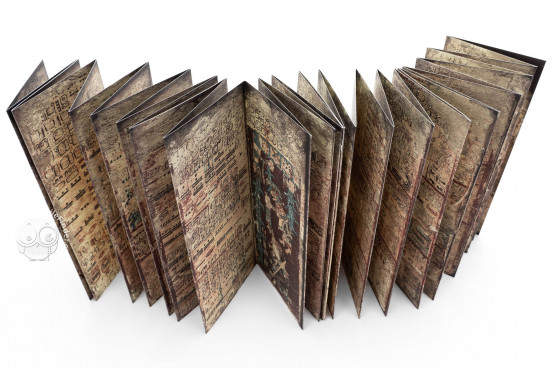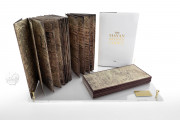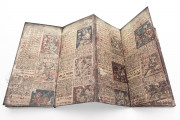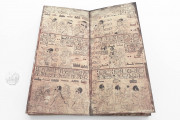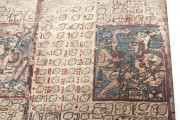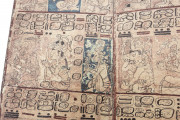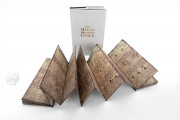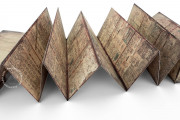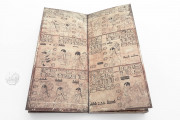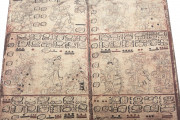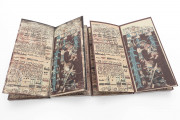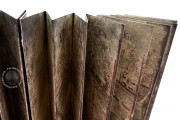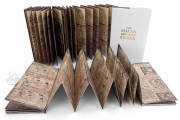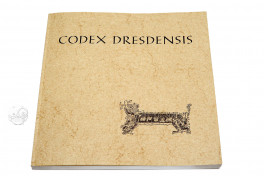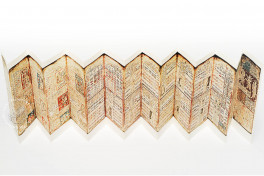The Codex Dresden is the most sophisticated of the four extant pre-conquest Maya manuscripts, the others including the Codex Paris and the Codex Madrid. Perhaps the oldest of the surviving Mesoamerican manuscripts, it was produced in the Yucatán Peninsula, probably in the fifteenth century, and includes material copied from an earlier manuscript or earlier manuscripts.
It is a book of time reckoning according to the Maya 260-day calendar and includes ceremonial requirements for rituals and tools for prognostications. It is composed of thirty-nine panels, most of which are painted on both sides, with seventy-four pages containing illustrations accompanied by explanatory hieroglyphs, using a system peculiar to the lowland Maya civilization.
The Mesoamerican Screenfold
Despite its nickname, the Codex Dresden, like most pre-Columbian books, is a screenfold manuscript, a long strip folded accordion style. When fully extended, it measures 20.5 x 340 cm. The support is amate paper (amatl in Nahuatl, hu'un in some Maya languages) formed from the inner bark of the fig tree. Thin strips of animal skin piece the paper segments together. The paper was covered with a thin layer of plaster on both sides. The paintings nearly fill both sides of the screenfold. The Codex Dresden was divided into two sections at some point, with one section flipped back to front when the pagination was added to the pages containing images. As a result, the contents of the manuscript are properly read in the page order 1-24, 46-74 (with one blank between 60 and 61), 25-45 (with three blank between 60 and 61). There probably once were wooden covers for the book.
Astronomy, Prognostication, and Ritual Presented in Grids
The contents of the Codex Dresden include almanacs according to the 260-day Maya calendar, tables for calculating the movements of the planets and lunar and solar eclipses according to the solar year, instructions for rituals, and a representation of the end of the universe in a great flood. Much of this content is presented on pages divided into two, three, or four registers, and many of those registers are further divided, creating a dazzling grid of illustrations and glyphs.
Regional Artistic Influences
The art of the Codex Dresden reveals a variety of regional influences. The Venus pages reveal Aztec influences dating to the pre-Maya era of the Yucatán region. Images of spear throwers using the atlatl are not typical of Maya art of this age and may betray another regional influence.
Many Artisans
The painter-scribes of the Dresden Codex were probably responsible for the compilation of its contents and also served as priests. They were, therefore, both the creators and the first users of the manuscript. Scholars have identified the work of eight painter-scribes in the Codex Dresden. Some of the painter-scribes were more careful in their planning than others, with some pages much more crowded. Two sorts of implement were used, brush pens made of animal hair mounted on reed handles, and quill pens fashioned from feathers. The color palette is dominated by black, brownish-red, and Maya blue.
From Conquest Treasure to Dresden
Hernán Cortés may have obtained the Codex Dresden on the island of Cozumel, a religious pilgrimage center off the coast of the Yucatán Peninsula, in 1517. It could have been part of "the royal fifth," twenty percent of acquired valuables required to be given to the royal treasury in Madrid, but there is no direct evidence for the manuscript's whereabouts until the eighteenth century. In 1739, Johann Christian Götze obtained the manuscript in Vienna for the Kurfürstliche Bibliothek zu Dresden. He described it as the first item in his publication of the "curiosities" of the library a few years later (1743). The library became the Königliche Bibliothek in 1906 and the Sächsische Landesbibliothek in 1917, and it became a part of the Sächsische Landesbibliothek – Staats- und Universitätsbibliothek in 2002.
We have 2 facsimiles of the manuscript "Codex Dresden":
- Codex Dresdensis facsimile edition published by Akademische Druck- u. Verlagsanstalt (ADEVA), 1976
- The Mayan Dresden Codex facsimile edition published by TGB Limited Editions, 2023

